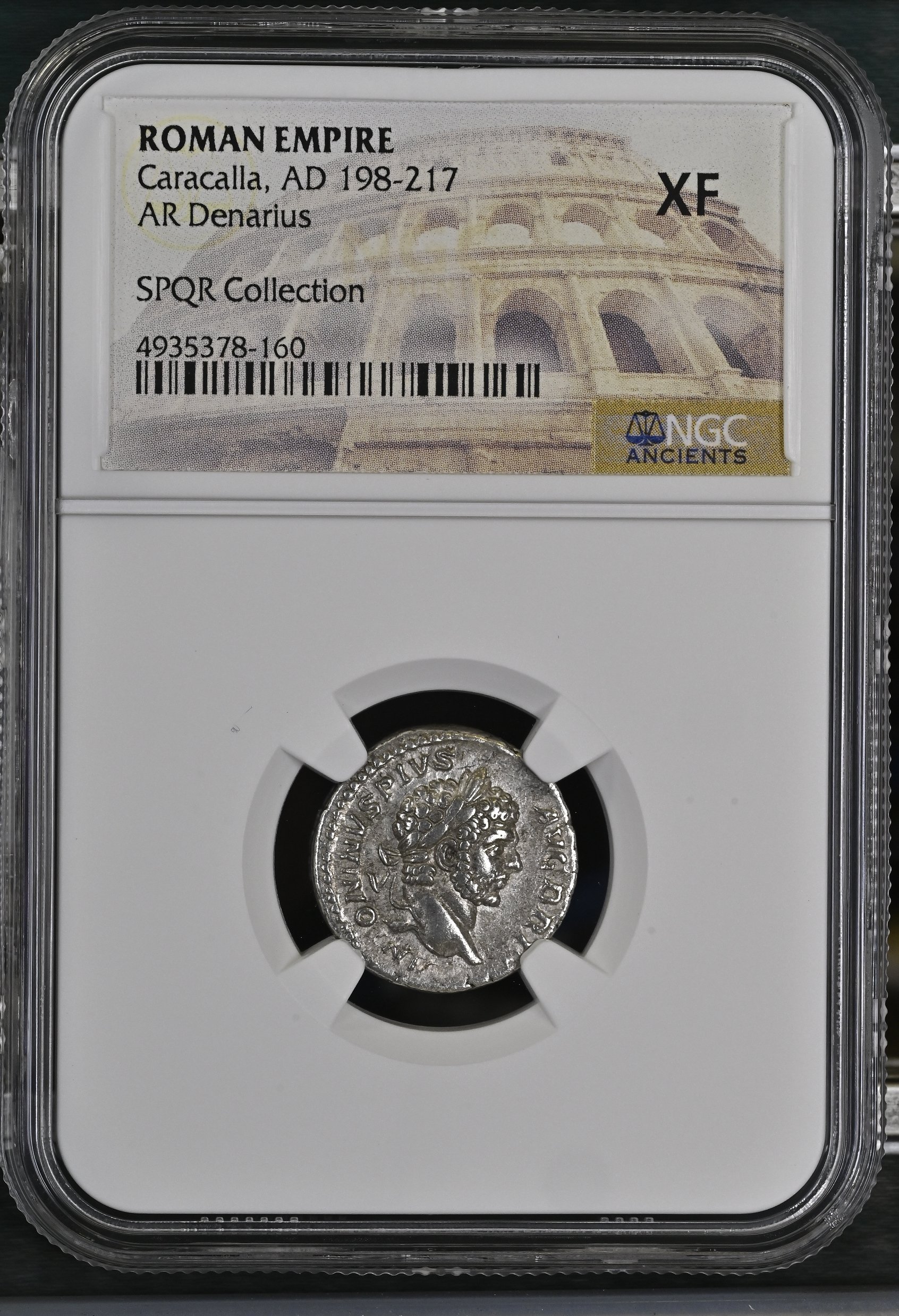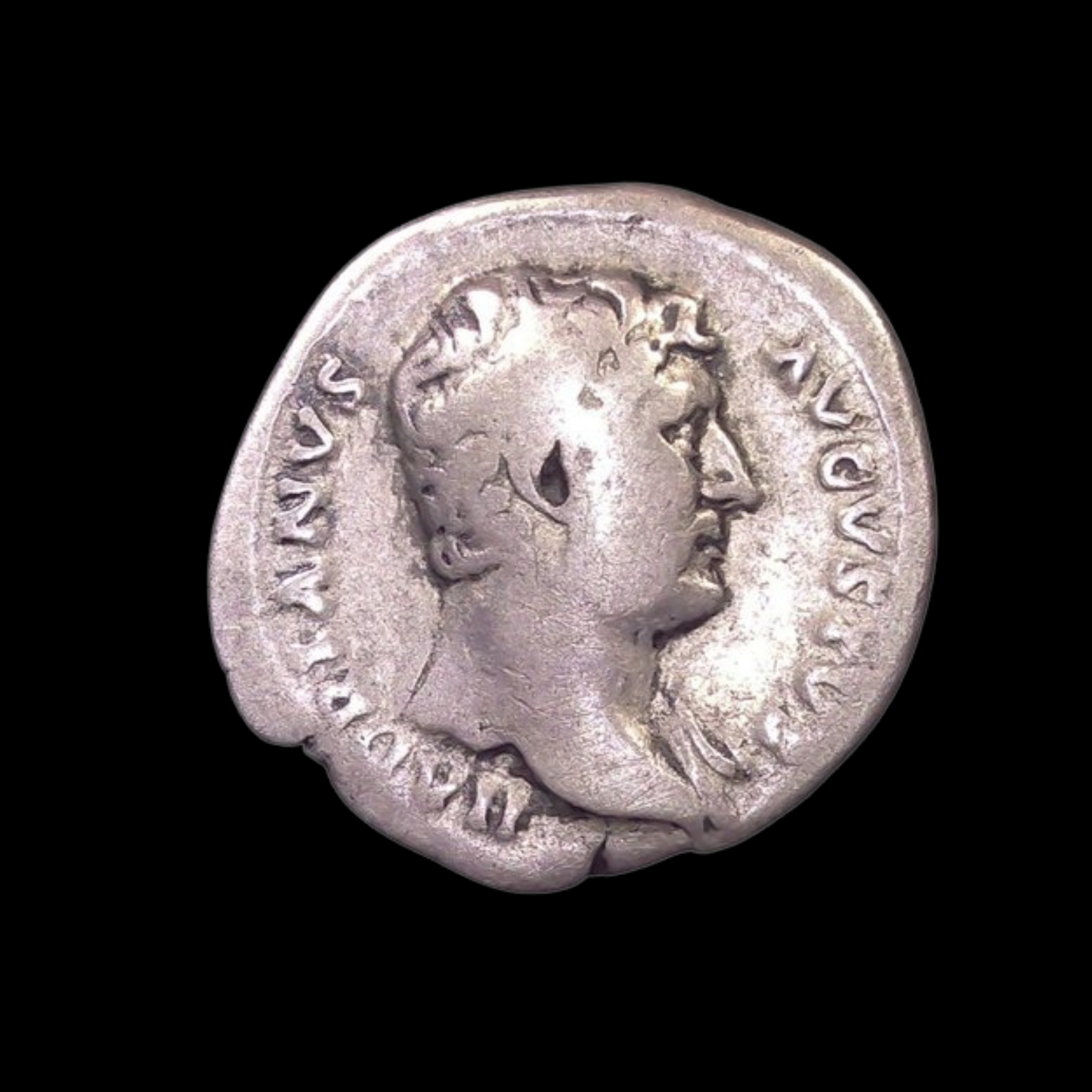 Image 1 of 2
Image 1 of 2

 Image 2 of 2
Image 2 of 2



Silver Denarius of Caracalla (about 1,810 years ago)
This silver denarius features Emperor Caracalla, born Lucius Septimius Bassianus and later renamed Marcus Aurelius Antoninus, who ruled the Roman Empire first jointly with his father Septimius Severus and brother Geta, then alone from 211 until his assassination in 217 CE. This high-grade example from the SPQR Collection showcases the coinage of a controversial emperor known for his brutal military campaigns and for granting Roman citizenship to all free men throughout the empire.
Coin Description:
Front side: The obverse displays the laureate (wreath-crowned) bust of Caracalla facing right, typically shown with a short beard, stern expression, and strong resemblance to his father. The surrounding Latin inscription would state his name and imperial titles.
Back side: Though not specified, the reverse would typically depict Roman deities (often Mars or Jupiter), personifications of virtues, military themes reflecting his campaigns, or other imperial propaganda imagery with accompanying Latin text.
Technical Details:
Silver composition (AR)
Denarius denomination (standard silver coin of the Roman monetary system)
Weight: Approximately 3-3.5 grams
Size: Approximately 18-20mm in diameter
NGC Grade: XF (Extremely Fine) - indicating excellent preservation with minor wear
Date of minting: 198-217 CE (spanning his time as Caesar and sole Augustus)
Collection: SPQR Collection
Historical Significance: This denarius was issued during a pivotal period in Roman history. Caracalla, named after a Gallic hooded cloak he favored wearing, became sole emperor after murdering his brother Geta in 211 CE. His reign was marked by military campaigns against Germanic tribes and Parthians, construction of the massive Baths of Caracalla in Rome (which could accommodate 1,600 bathers), and the issuance of the Constitutio Antoniniana in 212 CE, which extended Roman citizenship to nearly all free inhabitants of the empire. While presented as a generous act, this edict primarily aimed to increase tax revenue and potential military recruits. Caracalla also introduced a new coin, the antoninianus (double denarius), though it contained less than double the silver. He was assassinated in 217 CE while traveling to a temple near Carrhae (modern Harran, Turkey) by a disgruntled soldier, allegedly while relieving himself by the roadside. This exceptionally preserved denarius serves as a tangible link to an emperor whose actions fundamentally altered the concept of Roman citizenship and whose massive bath complex remains an impressive ruin in Rome today.
This silver denarius features Emperor Caracalla, born Lucius Septimius Bassianus and later renamed Marcus Aurelius Antoninus, who ruled the Roman Empire first jointly with his father Septimius Severus and brother Geta, then alone from 211 until his assassination in 217 CE. This high-grade example from the SPQR Collection showcases the coinage of a controversial emperor known for his brutal military campaigns and for granting Roman citizenship to all free men throughout the empire.
Coin Description:
Front side: The obverse displays the laureate (wreath-crowned) bust of Caracalla facing right, typically shown with a short beard, stern expression, and strong resemblance to his father. The surrounding Latin inscription would state his name and imperial titles.
Back side: Though not specified, the reverse would typically depict Roman deities (often Mars or Jupiter), personifications of virtues, military themes reflecting his campaigns, or other imperial propaganda imagery with accompanying Latin text.
Technical Details:
Silver composition (AR)
Denarius denomination (standard silver coin of the Roman monetary system)
Weight: Approximately 3-3.5 grams
Size: Approximately 18-20mm in diameter
NGC Grade: XF (Extremely Fine) - indicating excellent preservation with minor wear
Date of minting: 198-217 CE (spanning his time as Caesar and sole Augustus)
Collection: SPQR Collection
Historical Significance: This denarius was issued during a pivotal period in Roman history. Caracalla, named after a Gallic hooded cloak he favored wearing, became sole emperor after murdering his brother Geta in 211 CE. His reign was marked by military campaigns against Germanic tribes and Parthians, construction of the massive Baths of Caracalla in Rome (which could accommodate 1,600 bathers), and the issuance of the Constitutio Antoniniana in 212 CE, which extended Roman citizenship to nearly all free inhabitants of the empire. While presented as a generous act, this edict primarily aimed to increase tax revenue and potential military recruits. Caracalla also introduced a new coin, the antoninianus (double denarius), though it contained less than double the silver. He was assassinated in 217 CE while traveling to a temple near Carrhae (modern Harran, Turkey) by a disgruntled soldier, allegedly while relieving himself by the roadside. This exceptionally preserved denarius serves as a tangible link to an emperor whose actions fundamentally altered the concept of Roman citizenship and whose massive bath complex remains an impressive ruin in Rome today.
This silver denarius features Emperor Caracalla, born Lucius Septimius Bassianus and later renamed Marcus Aurelius Antoninus, who ruled the Roman Empire first jointly with his father Septimius Severus and brother Geta, then alone from 211 until his assassination in 217 CE. This high-grade example from the SPQR Collection showcases the coinage of a controversial emperor known for his brutal military campaigns and for granting Roman citizenship to all free men throughout the empire.
Coin Description:
Front side: The obverse displays the laureate (wreath-crowned) bust of Caracalla facing right, typically shown with a short beard, stern expression, and strong resemblance to his father. The surrounding Latin inscription would state his name and imperial titles.
Back side: Though not specified, the reverse would typically depict Roman deities (often Mars or Jupiter), personifications of virtues, military themes reflecting his campaigns, or other imperial propaganda imagery with accompanying Latin text.
Technical Details:
Silver composition (AR)
Denarius denomination (standard silver coin of the Roman monetary system)
Weight: Approximately 3-3.5 grams
Size: Approximately 18-20mm in diameter
NGC Grade: XF (Extremely Fine) - indicating excellent preservation with minor wear
Date of minting: 198-217 CE (spanning his time as Caesar and sole Augustus)
Collection: SPQR Collection
Historical Significance: This denarius was issued during a pivotal period in Roman history. Caracalla, named after a Gallic hooded cloak he favored wearing, became sole emperor after murdering his brother Geta in 211 CE. His reign was marked by military campaigns against Germanic tribes and Parthians, construction of the massive Baths of Caracalla in Rome (which could accommodate 1,600 bathers), and the issuance of the Constitutio Antoniniana in 212 CE, which extended Roman citizenship to nearly all free inhabitants of the empire. While presented as a generous act, this edict primarily aimed to increase tax revenue and potential military recruits. Caracalla also introduced a new coin, the antoninianus (double denarius), though it contained less than double the silver. He was assassinated in 217 CE while traveling to a temple near Carrhae (modern Harran, Turkey) by a disgruntled soldier, allegedly while relieving himself by the roadside. This exceptionally preserved denarius serves as a tangible link to an emperor whose actions fundamentally altered the concept of Roman citizenship and whose massive bath complex remains an impressive ruin in Rome today.
Marcus Aurelius Antoninus (born Lucius Septimius Bassianus, 4 April 188 – 8 April 217), better known by his nickname Caracalla (/ˌkærəˈkælə/),[3] was Roman emperor from 198 to 217 AD, first serving as nominal co-emperor under his father and then ruling alone after 211 AD. He was a member of the Severan dynasty, the elder son of Emperor Septimius Severus and Empress Julia Domna. Severus proclaimed Caracalla co-ruler in 198, doing the same with his other son Geta in 209. The two brothers briefly shared power after their father's death in 211, but Caracalla soon had Geta murdered by the Praetorian Guard and became sole ruler of the Roman Empire. Julia Domna had a significant share in governance, since Caracalla found administration to be mundane. His reign featured domestic instability and external invasions by the Germanic peoples.
Caracalla issued the Antonine Constitution (Latin: Constitutio Antoniniana), also known as the Edict of Caracalla, which granted Roman citizenship to all free men throughout the Roman Empire. The edict gave all the enfranchised men Caracalla's adopted praenomen and nomen: "Marcus Aurelius". Other landmarks of his reign were the construction of the Baths of Caracalla, the second-largest bathing complex in the history of Rome, the introduction of a new Roman currency named the antoninianus, a sort of double denarius, and the massacres he ordered, both in Rome and elsewhere in the empire. In 216, Caracalla began a campaign against the Parthian Empire. He did not see this campaign through to completion due to his assassination by a disaffected soldier in 217. Macrinus succeeded him as emperor three days later.
























